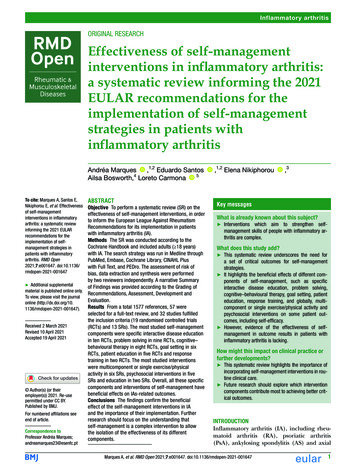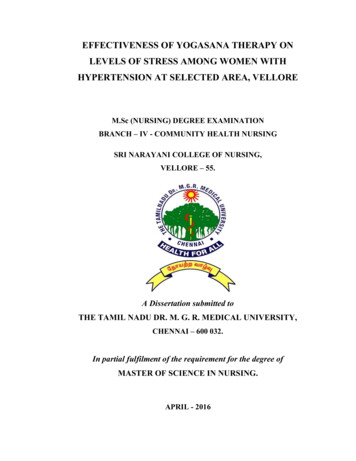
Transcription
Inflammatory arthritisORIGINAL RESEARCHEffectiveness of self- managementinterventions in inflammatory arthritis:a systematic review informing the 2021EULAR recommendations for theimplementation of self- managementstrategies in patients withinflammatory arthritisAndréa Marques ,1,2 Eduardo Santos ,1,2 Elena Nikiphorou ,3Ailsa Bosworth,4 Loreto Carmona 5To cite: Marques A, Santos E,Nikiphorou E, et al. Effectivenessof self- managementinterventions in inflammatoryarthritis: a systematic reviewinforming the 2021 EULARrecommendations for theimplementation of self- management strategies inpatients with inflammatoryarthritis. RMD Open2021;7:e001647. doi:10.1136/rmdopen-2021-001647ABSTRACTObjective To perform a systematic review (SR) on theeffectiveness of self- management interventions, in orderto inform the European League Against RheumatismRecommendations for its implementation in patientswith inflammatory arthritis (IA).Methods The SR was conducted according to theCochrane Handbook and included adults ( 18 years)with IA. The search strategy was run in Medline throughPubMed, Embase, Cochrane Library, CINAHL Pluswith Full Text, and PEDro. The assessment of risk ofbias, data extraction and synthesis were performedby two reviewers independently. A narrative Summary Additional supplementalof Findings was provided according to the Grading ofmaterial is published online only.Recommendations, Assessment, Development andTo view, please visit the journalEvaluation.online (http:// dx. doi. org/ 10. Results From a total 1577 references, 57 were1136/ rmdopen- 2021- 001647).selected for a full- text review, and 32 studies fulfilledthe inclusion criteria (19 randomised controlled trialsReceived 2 March 2021(RCTs) and 13 SRs). The most studied self- managementRevised 10 April 2021components were specific interactive disease educationAccepted 19 April 2021in ten RCTs, problem solving in nine RCTs, cognitive–behavioural therapy in eight RCTs, goal setting in sixRCTs, patient education in five RCTs and responsetraining in two RCTs. The most studied interventionswere multicomponent or single exercise/physicalactivity in six SRs, psychosocial interventions in fiveSRs and education in two SRs. Overall, all these specificcomponents and interventions of self- management have Author(s) (or theirbeneficial effects on IAs- related outcomes.employer(s)) 2021. Re- useConclusions The findings confirm the beneficialpermitted under CC BY.Published by BMJ.effect of the self- management interventions in IAand the importance of their implementation. FurtherFor numbered affiliations seeend of article.research should focus on the understanding thatself- management is a complex intervention to allowCorrespondence tothe isolation of the effectiveness of its differentProfessor Andréa Marques;components. andreamarques23@ esenfc. ptKey messagesWhat is already known about this subject? Interventionswhich aim to strengthen self- management skills of people with inflammatory arthritis are complex.What does this study add? This systematic review underscores the need fora set of critical outcomes for self- managementstrategies. It highlights the beneficial effects of different components of self- management, such as specificinteractive disease education, problem solving,cognitive–behavioural therapy, goal setting, patienteducation, response training, and globally, multicomponent or single exercise/physical activity andpsychosocial interventions on some patient outcomes, including self- efficacy. However, evidence of the effectiveness of self- management in outcome results in patients withinflammatory arthritis is lacking.How might this impact on clinical practice orfurther developments? This systematic review highlights the importance ofincorporating self- management interventions in routine clinical care. Future research should explore which interventioncomponents contribute most to achieving better critical outcomes.INTRODUCTIONInflammatory arthritis (IA), including rheumatoid arthritis (RA), psoriatic arthritis(PsA), ankylosing spondylitis (AS) and axialMarques A, et al. RMD Open 2021;7:e001647. doi:10.1136/rmdopen-2021-0016471
RMD Openspondyloarthritis (ax- SpA) or unspecified polyarthritis(UA), is the chronic conditions with a pervasive impacton daily self- care and quality of life.1 An essential aspectof adjusting to IA is the ability to understand the diseaseand deal with the practical, physical and psychologicalimpacts that come along with it.2 This goes beyond drugtherapy and implies the recognition that the diagnosis ofIA is life- changing, and that the ability to self- manage iscrucial.3Self- management, unlike the traditional medicalmodel, emphasises the importance of interactive, collaborative care between the patient and the healthcareprofessional rather than one- way, passive care fromexpert to patient. Although several educational materialsand resources may be available for self- management ofIA, these are often underused and not always incorporated in the routine care. Time pressures, limited healthcare services, the perceived lack of evidence but also thelack of knowledge of healthcare professionals as to who isavailable and what resources are available to best addressself- management aspects of care, are recognised obstacles to providing the necessary support in a sensitive andpatient- centred manner.4Several European Alliance of Associations for Rheumatology (EULAR) recommendations for the managementof specific RMDs have highlighted the importance of self- management to achieve the desired effect of interventions.5–9 However, these recommendations do not orientclinicians and healthcare professionals on how to supportpatients to self- management, acquire self- managementskills and make necessary behavioural changes.In order to inform the task force responsible for the2021 EULAR Recommendations for the implementation of self- management strategies in patients with IA,we performed a systematic review (SR) that aimed toidentify the best evidence on the effectiveness of self- management interventions targeting IA and to describetheir components.METHODSThis SR was conducted according to the Cochrane Handbook10 and reported following the Preferred ReportingItems for Systematic Reviews and Meta- Analyses guidelines.11The steering group of the EULAR task force (AM,ES, EN, AB and LC) established and followed the SRprotocol, which was not registered, but is available onrequest. The outlined research questions, as approved bythe entire task force at the first meeting, were: which self- management interventions are effective in IA? Which arethe components of effective interventions? Who are theprofessionals who deliver these effective interventions?These questions were framed and structured accordingto the EULAR standardised operating procedures12 usingthe ‘Patients, Intervention, Comparator or Control,Outcome, Type of study format’.2ParticipantsA study was eligible for inclusion if the participantsincluded were adults ( 18 years) with IA (specifically,RA, PsA, AS, ax- SpA or UA). To maximise precision,only studies in which patients were formally diagnosedwith IA or who satisfied current disease criteria, wereincluded.13–16 Studies focusing on the informationregarding patients with other concomitant diseases,whether these were rheumatic or not, were excludedfrom the synthesis.InterventionsWith regards to eligible interventions, these had to bedefined explicitly as ‘self- management’, in other words,the individual patient ability and competence regardingthe management of symptoms, treatment, physical andpsychosocial consequences and the lifestyle changesinherent in living with a chronic condition17; or theyhad to include at least one component from each of thefollowing: biological, psychological and social management. Interventions must consist of disease information, medication management, management of thephysical activity, disease- related problem solving, cognitive symptom management, management of emotions,communication skills and use of community resources.18Additionally, these interventions should be promotedby, or result from interaction with a programme leaderwho is a health professional. They may be delivered faceto face or online, with direct or indirect trained supportprovided.Comparator or controlThe comparator was placebo or usual care (standardcare).ContextThere were no contextual constraints in this SR.OutcomesConcerning outcomes, the core concept in self- management is the realisation of self- efficacy; that is,confidence in oneself to carry out the required behaviourto acquire the desired goal.19 We accepted other patient- reported outcome measures that were quantitative measures of the impact of the disease, such as pain, functionaldisability, fatigue, emotional well- being, sleep, coping andphysical well- being (eg, Visual Analogue Scale, HealthAssessment Questionnaire, Functional Assessment ofChronic Illness Therapy, Rheumatoid Arthritis Impactof Disease).20 21 Health- related quality of life (eg, 36- ItemShort Form Survey, EuroQol-5 Dimension).22 Self- efficacyshould be measured by a validated tool (eg, General Self- Efficacy Scale or Stanford Self- Efficacy Scale].Type of studyEligible designs were only SR and randomised controlledtrials (RCTs) or controlled clinical trials because theyare the most robust designs and represent the highestevidence.Marques A, et al. RMD Open 2021;7:e001647. doi:10.1136/rmdopen-2021-001647
Inflammatory arthritisFigure 1Flow chart of the study selection and inclusion process.Search strategy and study selectionA search strategy was run in Medline through PubMed,Embase, Cochrane Library, CINAHL Plus with Full Text,and PEDro from 20 January 2020 to 24 January 2020.Studies published in English, French, Spanish, and Portuguese language, with no restriction of the publicationdate, were considered for inclusion. Details on completesearch strategies are provided in online supplementalmaterial S1.All identified citations were uploaded into an EndNoteVX7 (Clarivate Analytics, Pennsylvania, USA) libraryand the duplicates removed. Titles and abstracts werescreened by two independent reviewers (ES and AM) toassess eligibility criteria. The full articles were retrievedAssessment of risk of bias, data extraction and synthesisTwo reviewers (ES and AM) independently assessed therisk of bias of each included study using the AMSTAR2 forSR23 and the Cochrane Collaboration’s tool for RCT’s.24Any disagreements between the reviewers were resolvedthrough discussion, or with a third reviewer (LC).Data were extracted from the selected reports bythe same two independent reviewers (ES and AM),Marques A, et al. RMD Open 2021;7:e001647. doi:10.1136/rmdopen-2021-0016473for all studies that met or had insufficient informationto assess these inclusion criteria, and two reviewers (ESand AM) independently examined them in detail. Anydisagreements that arose between the reviewers wereresolved through discussion or with a third reviewer (LC).
RMD OpenTable 1 Short version of GRADE Summary of avioral therapyFunctional disabilityEffectiveDisease iety/depressionEffectivePsychophysiological complainsEffectiveSleep problemsEffectivePainEffectiveSelf- efficacy/self- helplessnessEffectiveQuality of life/health status/socialsupportEffectiveHealthcare useNo effectResponse trainingSpecific interactive diseaseeducationGoal setting4FatigueEffectiveFunctional disabilityEffectiveDisease chophysiological complainsNo effectPainEffectiveSelf- Efficacy/self- helplessnessEffectiveQuality of life/Health edgeEffectiveFunctional disabilityEffectiveDisease iety/depressionNo effectPsychophysiological complainsNo effectPainEffectiveSelf- efficacy/self- helplessnessEffectiveQuality of life/health ional disabilityEffectiveDisease iety/depressionEffectivePsychophysiological complainsEffectiveSleep problemsEffectivePainEffectiveSelf- efficacy/self- helplessnessEffectiveQuality of life/health inty of the evidence(GRADE) LOW LOW MODERATE LOW LOW LOW LOW MODERATE LOW LOW MODERATE MODERATE MODERATE MODERATE LOW MODERATE MODERATE MODERATE MODERATE MODERATE LOW LOW LOW MODERATE MODERATE LOW LOW LOW LOW LOW LOW MODERATE LOW LOW MODERATE LOW LOW LOW LOWContinuedMarques A, et al. RMD Open 2021;7:e001647. doi:10.1136/rmdopen-2021-001647
Inflammatory arthritisTable 1 ContinuedInterventionsOutcomesImpactProblem solvingFunctional disabilityEffectiveDisease iety/depressionEffectivePsychophysiological complainsEffectiveSleep problemsEffectivePainEffectiveSelf- efficacy/self- helplessnessEffectiveQuality of life/health status/socialsupportEffectiveHealthcare useNo effectFatigueEffectivePainEffectiveFunctional disabilityEffectiveFatigueEffectivePatient Global S-28No effectPainEffectiveFunctional disabilityEffectiveFatigueEffectivePsychological statusEffectivePhysical veTender jointsEffectiveCopingEffectiveSelf- efficacyEffectiveDAS-28No effectSelf- management interventionsPainEffectiveFunctional disabilityNo effectEducational al disabilityEffectiveJoint countsEffectivePatient Global AssessmentEffectivePsychological veSelf- efficacyEffectiveMulticomponent or singleexercise/physical activityinterventionsPsychosocial interventionsCertainty of the evidence(GRADE) LOW LOW LOW LOW LOW MODERATE LOW LOW LOW MODERATE LOW MODERATE LOW HIGH MODERATE LOW LOW VERY LOW MODERATE MODERATE MODERATE MODERATE MODERATE MODERATE MODERATE MODERATE MODERATE MODERATE VERY LOW LOW VERY LOW MODERATE VERY LOW MODERATE MODERATE MODERATE MODERATE MODERATE MODERATE MODERATEContinuedMarques A, et al. RMD Open 2021;7:e001647. doi:10.1136/rmdopen-2021-0016475
RMD OpenTable 1 ContinuedInterventionsOutcomesImpactCertainty of the evidence(GRADE)GRADE Working Group grades of evidence. High certainty: We are very confident that the true effect lies close to that of theestimate of the effect; Moderate certainty: We are moderately confident in the effect estimate: The true effect is likely to beclose to the estimate of the effect, but there is a possibility that it is substantially different; Low certainty: Our confidence inthe effect estimate is limited: The true effect may be substantially different from the estimate of the effect; Very low certainty:We have very little confidence in the effect estimate: The true effect is likely to be substantially different from the estimate ofeffect.BASDAI, Bath Ankylosing Spondylitis Disease Activity Index; BASFI, Bath Ankylosing Spondylitis Functional Index; DAS-28,Disease Activity Score-28; GRADE, Grading of Recommendations, Assessment, Development and Evaluation.and disagreements were discussed until consensus wasachieved, with the third reviewer (LC) involved whenevernecessary. Authors of papers were contacted to requestmissing or additional data, where required. The overlapof original research studies included in SRs was rigorously checked to avoid double counting and expressedas percentage.An overall assessment of the quality of the evidence foreach comparison (intervention vs control) was performedusing the Grading of Recommendations, Assessment,Development and Evaluation25 and Summary of Findings(SoF) tables were produced with the GRADEPro GDTsoftware. A four- point rating scale was used to rate thequality of the evidence (high, moderate, low and verylow), according to the following criteria: risk of bias,inconsistency, imprecision, indirectness and publicationbias. A narrative SoF form was preferred due to the differences in metrics used by the included studies.RESULTSFrom a total of 1577 references, 57 were selected for a full- text review, and 32 studies fulfilled the inclusion criteria.Full- text studies that did not meet the inclusion criteriawere excluded, and reasons for exclusion are provided inonline supplemental material S2. Included studies were19 RCTs and 13 SRs. As a result of the overlap, 91 RCTs(34.9%) were duplicated in the SRs. Only one authorof the papers was contacted to request additional information. The results of the searches are shown in a flowdiagram (figure 1).moderate to high quality, except for one, that was low. Ingeneral, all RCTs had issues with allocation concealmentand blinding of participants and outcomes, which mightbe expected given the nature of the intervention.Characteristics of included studies and interventionsStudy characteristics are detailed in online supplemental material S4. Regarding interventions, the mostcommonly studied among the 19 RCTs were specificinteractive disease education (n 10),26–35 problemsolving (n 9),26 28 32 33 35–40 cognitive–behavioural therapy(n 8),32 33 38–43 goal setting (n 6),26 32 35–38 40 patient education (n 5),35–37 41 44–46 and response training (n 2).32 34 Ofnote, several RCTs had addressed more than one intervention.Of the 13 included SRs, the most studied interventionswere multi- component or single exercise/physical activity(n 6),47–52 psychosocial interventions (n 5),47 53–56 education (n 2)57 58 and self- management (n 1).59 Studieswere very heterogeneous from a methodological, clinicaland even statistical point of view; thus, data pooling wasnot possible. Table 1 and online supplemental materialS5 provide a summary on the effects of interventions peroutcome.Methodological qualityThe critical appraisal results for each of the studies aresummarised in online supplemental material S3. Therewas agreement among the reviewers to include all thestudies that were appraised. Regarding SRs, most (n 9)had moderate quality, three had high quality and onlyone was of low quality. This lower quality was mainlydue to problems of no explicit statement that the reviewmethods were established prior to the conducting ofthe review, issues in selection of the study designs, insufficient search strategy, not providing a list of excludedstudies and justifying the exclusions, not reporting onthe sources of funding and not investigating the publication bias. The majority of the RCTs included were ofDISCUSSIONThis SR shows some beneficial effects of componentsof self- management, such as specific interactive diseaseeducation,26–35 problem solving,26 28 32 33 35–40 cognitive–behavioural therapy,32 33 38–43 goal setting,26 32 35–38 40 patienteducation35–37 41 44–46 and response training.32 34 Also,multicomponent or single exercise/physical activity,47–52psychosocial interventions,47 53–56 education57 58 and self- management,59 in general, also corroborate this trend.Several other studies explored the effectiveness of self- management interventions in undifferentiated chronicdiseases or other rheumatic diseases besides IA.60–64Other outcomes, for example, disease activity, healthcareuse, psychophysiological complaints, anxiety/depressionand functional disability, were either controversial or hadno positive effect.The presentation of the findings by individual components of the self- management interventions was drivenprimarily by the heterogeneity of the interventions,which did not allow ‘points of convergence’. As shown in6Marques A, et al. RMD Open 2021;7:e001647. doi:10.1136/rmdopen-2021-001647
Inflammatory arthritistable 1, there is no high certainty of the evidence on self- management interventions in IA, and most of the certaintyof evidence is moderate or low. This is natural becauseself- management is a so- called ‘complex intervention’.In complex interventions, the efficacy of specific components is difficult to isolate.65 The majority of interventions included some sort of patient education, problemsolving and cognitive–behavioural therapy which are tobe expected in the context of self- management.The interventions were delivered by a range of healthcare professionals including rheumatologists, nurses,psychologists, nutritionists, physiotherapists, occupational therapists, social workers and dieticians. Besidesthem, the multidisciplinary teams that delivered theinterventions also included laypersons, pairs of layleaders, counsellors and yoga teachers, although with asmaller participation.No expert patients were involved in the delivery ofeducation or interventions based on the published literature, which is in contrasts to what is being offered atleast by some patient organisations. This observation wasperhaps due to the setting of the studies (mainly hospitals (secondary care)), the year of the publication of themost long- standing studies which is still not sensitive tothe growing patient research partners paradigm, and dueto a pure research context of the study.Surprisingly, only one study measured adherence as anoutcome of patient education.46 Whereas several studieshave examined adherence, only one RCT focused on theeffect of self- management strategies (patient education)to improve it. This could be due to research bias or difficulties. The effect of patient education on adherence ispositive, despite being based on a few patients and shorttime of follow- up.Another issue that has not been the subject ofthis review, but that deserves attention, is the cost- effectiveness of the self- management interventions. Twoof the excluded RCTs presented economic results andpointed out discrepancy in results. One,66 concluded thatself- management programmes represent a cost- effectiveuse of resources compared with usual care with a 20000– 30 000/QALY gained and leads to lower healthcare costs and work absence. The other,67 suggested thatalthough self- management improves the quality of life, itdoes so with a higher cost (Δ 4211). This increased costsubstantially reduced when medication costs were left outof the equation (Δ 1863). Further economic studiesare warranted to provide greater clarity on the subject.In conclusion, several issues limit and make it difficult to state recommendations that can be made forthe implementation of self- management interventionsin IA. Well- structured self- management programmesare lacking or are poorly reported,68 and this is probably due to the articles’ word- count constraints. Onthe other hand, self- management behaviours are influenced by sociodemographic variables, health status anddisease.69 This may lead to some components not havingthe same applicability between different contexts orMarques A, et al. RMD Open 2021;7:e001647. doi:10.1136/rmdopen-2021-001647countries. The multiform way of offering these interventions also makes it difficult to analyse their individual effectiveness because most of them are centred inhospitals, which is distorted by the very concept of self- management interventions. Professionals should lookout for ‘new ways’ that are more adjusted and closer tothe patient needs, such as internet programmes, whichare proven to be effective in improving health statusmeasures at 1 year.62 67 At last, there are even challengesin better defining which outcomes should be measuredin self- management interventions.70 In the future, aformal outcomes core set should be established in self- management interventions.Author affiliations1Rheumatology Department, Centro Hospitalar e Universitário de Coimbra EPE,Coimbra, Portugal2Higher School of Nursing of Coimbra, Health Sciences Research Unit: Nursing,Coimbra, Portugal3Centre for Rheumatic Diseases, King College London, London, UK4National Rheumatoid Arthritis Society, Littlewick Green, UK5Instituto de Salud Musculoesquelética, Madrid, SpainTwitter Eduardo Santos @EduardoJFSantos, Elena Nikiphorou @ElenaNikiUK andLoreto Carmona @carmona loretoCollaborators Ailsa Bosworth (UK) ailsa@ nras. org. uk; Elena Nikiphorou (UK) enikiphorou@ gmail. com; Loreto Carmona (Spain) loreto. carmona@ inmusc. eu; Andrea Marques (Portugal) andreamarques23@ gmail. com; Eduardo Santos(Portugal) ejf. santos87@ gmail. com; Claire Daien (France) cidaien@ gmail. com;Codruta Zabalan (Romania) c odruta. filip@ gmail. com; George Fragoulis (Greece) geofragoul@ yahoo. gr; Bente Appel Esbensen (Denmark) bente. appel. esbensen@ regionh. dk; Annette de Thurah (Denmark) annethur@ rm. dk; George Metsios (UK) g. metsios@ wlv. ac. uk; Hans Biljsma (Netherlands) j. w. j. bijlsma@ umcutrecht. nl; Hayley McBain (UK) h ayley. mcbain. 1@ city. ac. uk; Pat Holmes (UK) patricia. karma22@ gmail. com; Peter Boehm (Germany) peboehm@ gmx. de; Ricardo Ferreira(Portugal) ferreira. rjo@ gmail. com; Rikke Helene Moe (Norway) rikmoe@ gmail. com;Sarah Ryan (UK) sarah. ryan@ uhns. nhs. uk; Tanja Stamn (Austria) tanja. stamm@ meduniwien. ac. at.Contributors All authors are members of the EULAR’s task force for thedevelopment of 2021 EULAR Recommendations for the implementation ofself- management strategies in patients with inflammatory arthritis. AM and ESwere the fellows. EN and AB were the convenors. LC was the methodologist. Allauthors have contributed to the work, read and finally approved the manuscriptfor submission.Funding This study was funded by the European League Against RheumatismEULAR (Project (PARE- led) PAR028: EULAR Recommendations for theimplementation of self- management strategies in patients with InflammatoryArthritis.Competing interests None declared.Patient consent for publication Not required.Provenance and peer review Not commissioned; externally peer reviewed.Data availability statement Data sharing not applicable as no datasets generatedand/or analysed for this study. All data relevant to the study are included in thearticle or uploaded as supplementary information. Data sharing not applicable asno datasets generated and/or analysed for this study. All data relevant to the studyare included in the article or uploaded as supplementary information.Open access This is an open access article distributed in accordance with theCreative Commons Attribution 4.0 Unported (CC BY 4.0) license, which permitsothers to copy, redistribute, remix, transform and build upon this work for anypurpose, provided the original work is properly cited, a link to the licence is given,and indication of whether changes were made. See: https:// creativecommons. org/ licenses/ by/ 4. 0/.ORCID iDsAndréa Marques http:// orcid. org/ 0000- 0002- 2026- 9926Eduardo Santos http:// orcid. org/ 0000- 0003- 0557- 2377Elena Nikiphorou http:// orcid. org/ 0000- 0001- 6847- 3726Loreto Carmona http:// orcid. org/ 0000- 0002- 4401- 25517
RMD OpenREFERENCES1 WHO. WHO scientific group on the burden of musculoskeletalconditions at the start of the new millennium. The burden ofmusculoskeletal conditions at the start of the new millenium: reportof a WHO scientific group. Geneve; 2003.2 Taylor SJC, Pinnock H, Epiphaniou E. Health services and deliveryresearch. A rapid synthesis of the evidence on interventionssupporting self- management for people with long- term conditions:prisms – practical systematic review of self- management supportfor long- term conditions. Southampton, UK NIHR Journals Library;2014.3 Kvien TK, Balsa A, Betteridge N, et al. Considerations for improvingquality of care of patients with rheumatoid arthritis and associatedcomorbidities. RMD Open 2020;6:e001211.4 Kielmann T, Huby G, Powell A, et al. From support to boundary: aqualitative study of the border between self- care and professionalcare. Patient Educ Couns 2010;79:55–61.5 Baillet A, Gossec L, Carmona L, et al. Points to consider forreporting, screening for and preventing selected comorbidities inchronic inflammatory rheumatic diseases in daily practice: a EULARinitiative. Ann Rheum Dis 2016;75:965–73.6 Smolen JS, Breedveld FC, Burmester GR, et al. Treating rheumatoidarthritis to target: 2014 update of the recommendations of aninternational Task force. Ann Rheum Dis 2016;75:3–15.7 Zangi HA, Ndosi M, Adams J, et al. EULAR recommendations forpatient education for people with inflammatory arthritis. Ann RheumDis 2015;74:954–62.8 Fernandes L, Hagen KB, Bijlsma JWJ, et al. EULARrecommendations for the non- pharmacological core management ofhip and knee osteoarthritis. Ann Rheum Dis 2013;72:1125–35.9 Rausch Osthoff A- K, Niedermann K, Braun J, et al. 2018 EULARrecommendations for physical activity in people with inflammatoryarthritis and osteoarthritis. Ann Rheum Dis 2018;77:1251–60.10 Higgins JPT, Thomas J, Chandler J. Cochrane Handbook forsystematic reviews of interventions version 6.0, 2019. Available:www. training. cochrane. org/ handbook11 Moher D, Liberati A, Tetzlaff J, et al. Preferred reporting items forsystematic reviews and meta- analyses: the PRISMA statement.PLoS Med 2009;6:e1000097.12 van der Heijde D, Aletaha D, Carmona L, et al. 2014 update of theEULAR standardised operating procedures for EULAR- endorsedrecommendations. Ann Rheum Dis 2015;74:8–13.13 Arnett FC, Edworthy SM, Bloch DA, et al. The American rheumatismassociation 1987 revised criteria for the classification of rheumatoidarthritis. Arthritis Rheum 1988;31:315–24.14 Aletaha D, Neogi T, Silman AJ, et al. 2010 rheumatoid arthritisclassification criteria: an American College of Rheumatology/European League against rheumatism collaborative initiative.Arthritis Rheum 2010;62:2569–81.15 Taylor W, Gladman D, Helliwell P, et al. Classification criter
Chronic Illness Therapy, Rheumatoid Arthritis Impact of Disease).20 21 Health-related quality of life (eg, 36- Item Short Form Survey, EuroQol-5 Dimension). 22Self- efficacy should be measured by a validated tool (eg, General Self- Efficacy Scale or Stanford Self-Efficacy Scale]. Type of stud










